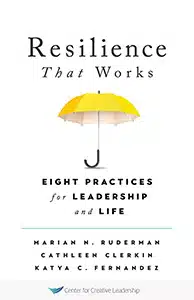You’ve been preparing for days, and the time has arrived. In minutes, you’ll meet with your boss and make the case for a promotion that you know is well-deserved. Your palms are sweaty, your stomach is filled with butterflies, and you feel an acute sense of excitement.
This is the kind of stress we need to perform at our best. A popular TED talk by Stanford professor Kelly McGonigal credits stress with enhancing our creativity, fitness, immune systems, and problem-solving skills — as long as we handle it the right way.
Unfortunately, when most people experience leadership stress, it’s not in anticipation of an upcoming challenge. Usually, it’s a sense of dread associated with continuously striving to do more with less.
In many cases, that dread is only magnified by the process of rumination — thinking about experiences from the past or imagining scenarios in the future and attaching negative emotions to them.
It’s not that thinking about past events is bad, necessarily, but fixating on them leads to harmful health outcomes, and rumination is the number one cause of stress.
In order to reduce leadership stress and burnout and become more resilient, leaders first have to recognize how much time they spend ruminating about things that produce no useful outcomes.
The next step is to channel that negative energy into reflection, rumination’s positive flip side. Free from past regrets and anxiety about the future, reflective leaders are better able to succeed in the moment and prepare for the future.
3 Ways Leadership Stress Affects You
From conflict resolution to decision-making and people development, a long list of task-related and interpersonal workplace demands contribute to rumination and leadership stress.
As you experience your body’s physiological responses to these stressful demands, you may assume that you understand what it means for stress to have an “adverse impact on your health.” But some of leadership stress’s most damaging side effects go unnoticed in the short term and only manifest themselves over the long term.
If you consistently feel stressed, you’re probably doing a lot of rumination, which affects your body in 3 main ways:
- Ruminating affects your health by releasing 2 hormones into your system. The first hormone is adrenaline, which causes your heart to speed up. As your heart pumps faster, blood hits the artery walls, and plaque builds up. Over time, that can lead to an increased risk of a heart attack. The second is the steroid hormone, cortisol. In order to produce cortisol, your body puts white blood cell production on hold. Without adequate white blood cell production, your immune system is suppressed, and you’re more susceptible to illness.
- Stress affects your attitude. People who frequently ruminate because they’re stressed often verbalize their thoughts. Verbal rumination not only perpetuates the negative emotions they’ve associated with their experiences, but it also affects the attitude and resilience of those around them. Negative self-talk is particularly unhelpful in uncertain times.
- Rumination affects your productivity. It’s hard to focus if you’re spending the majority of your time ruminating. As a result, you’re often less productive at work.
 Dive deeper into 8 practices that keep you healthy, focused, and functioning with our book, Resilience That Works: Eight Practices for Leadership and Life.
Dive deeper into 8 practices that keep you healthy, focused, and functioning with our book, Resilience That Works: Eight Practices for Leadership and Life.
7 Strategies for Combating Leadership Stress
How to Counter the Harmful Effects
According to our research, leaders most often turn to sensory pursuits as a form of stress management. These pursuits range from activities that provide healthy physical stimulation, like running, to risky behaviors, such as punching a wall in frustration or overeating.
Because leaders rely so heavily on sensory pursuits, it’s important to find go-to activities, such as exercising or listening to music, that relieve your stress while also contributing to your overall health.
In addition to drawing on positive sensory pursuits, leaders can take the following actions to counter the harmful effects of stress.
1. Recognize your stress signals.
Learn to pay attention to your body’s responses to leadership stress. What triggers a feeling of stress, and what are your physiological responses? Do you feel your heart rate going up? Do you get hot? Do you clench your jaw? The sooner that you recognize your body going into stress mode, the sooner you can take action to manage it.
2. Incorporate health and a proper diet into your schedule.
A healthy sensory pursuit, exercise helps leaders reduce their anxiety, improve their sleep, and boost their immunity from colds and the flu. Exercise and dietary changes can support brain health but are more sustainable when they’re incorporated slowly. Begin by adding more fruits and vegetables into your diet, while reducing added sugars, fats, and sodium. Then make a commitment to exercising at least 30 minutes, twice a week.
3. Maintain boundaries between home and work life.
This starts by setting expectations. Share your work hours and preferred communication channels with your team. Control as much as you can of your schedule to live with intention both at work and at home.
4. Enlist a coach to help you stay on track.
A coach can support you and help you uncover ways to boost your energy and maximize your time. Together, you can determine which of your responsibilities are essential, and which ones are patterns of behavior you’ve created that may not be necessary.
5. Create your personal board of directors.
Make sure you have a support group in place that is helping you positively cope with stress and leadership. This diverse group can provide different types of support and should include your peers, your boss, a family member, and a trusted friend. Be clear about your stress-management goals, and ask your advisers for help staying on track.
6. Practice the art of recovery.
Athletes have long understood that pushing oneself hard at 100% capacity, 100% of the time results in little or no long-term performance gains. Make sure that throughout your day, you give yourself frequent breaks. Get up from your desk and walk around, or get outside for some fresh air. After an extended push on a project or assignment, take a vacation, or at least unplug while at home. Learn about other practices for recovery from overwork.
7. Focus your attention on the present.
When you find yourself ruminating, connect with your 5 senses, and then come back into the present. Refocus your attention by asking yourself: What can I control right now?
Combat Leadership Stress by Increasing Focus & Reflection
A key way to banish leadership stress is through mindfulness and taking time for reflection.
Many times, an inability to focus on a particular demand leads to leadership stress. With communications coming from seemingly every direction, it’s easy for leaders to feel completely overwhelmed and at a loss for where to begin.
John Ryan, our former president and CEO, starts each day with a routine he’s relied on for many years. Instead of jumping straight into checking his email account, he pours a cup of coffee and reads a brief passage from one of his favorite books on leadership. Then he reviews a short list of strategic initiatives that need attention.
“After reflection, I’ll consider the actions required for each item — and either take those actions right away, or set aside time on the schedule later that day for them,” Ryan says. “Inevitably, the day’s meetings start, and the emails multiply. But that’s OK because I’ve already enjoyed the white space needed to feel focused and in charge.”
In addition to using “white space” — open time that helps you take control of your schedule — he also recommends the following actions, which can help you gain focus on priorities:
- Define and clarify the expectations of your tasks.
- Maintain a project schedule.
- Complete tasks ahead of deadline.
Each of these behaviors can help to put a stressful task in perspective with your organization’s overall goals. Not only can they relieve leadership stress in the moment, but they can also help to eliminate future stress, before a task is even started.
Ready to Take the Next Step?
Empower your team to develop more resilient leadership and habits that create conditions for peak performance with our resilience-building solutions, which will help your leaders avoid burnout — and burn bright instead.










